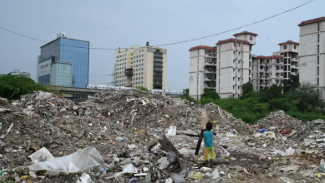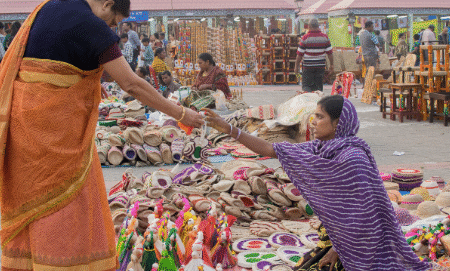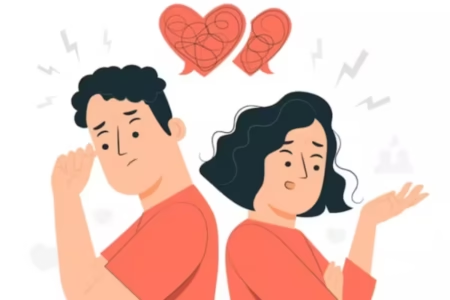In early August 2025, a single, sharply worded social media post turned a festering local nuisance in Gurugram into an administrative sprint. A Delhi-based woman, Anuradha Tiwari, posted a photograph of a large roadside garbage heap and called for volunteers to collect the trash and dump it “outside ministers’ bungalows.” The provocation was deliberate, the frustration palpable—and the results were immediate. Within hours of the post going viral on X (formerly Twitter), the Municipal Corporation of Gurugram (MCG) dispatched crews to the spot and cleared the area, later sharing proof-of-cleaning images to confirm action. Multiple outlets chronicled the chain reaction: outrage → virality → rapid remediation. It was a crisp demonstration of how visibility and public pressure can compress civic timelines from weeks to mere hours. The episode resonated so widely because it wasn’t a one-off grievance in a spotless city. Residents have been documenting Gurugram’s waste management troubles for months: overflowing roadside dumps, inconsistent pickup schedules, and the persistent scourge of illegal dumping. Reporters have watched as car after car casually offloaded polybags on vacant plots, normalizing what should be unacceptable. On social feeds and neighborhood groups, the images piled up alongside complaints that the system—contractors, monitoring, and enforcement—wasn’t keeping pace with the city’s growth. The viral post struck a nerve precisely because it captured a routine indignity that thousands recognized. That pressure has coincided with official attempts to change course. The MCG recently signaled a tougher stance on illegal dumping by invoking Section 15 of the Environment (Protection) Act, 1986, which allows fines and even imprisonment for violators. Vehicles caught dumping can be seized and blacklisted; at least one contractor has already been fined ₹1 lakh after residents flagged an incident. Administrators have also been urged to strengthen segregation norms and hold bulk waste generators accountable—moves meant to shift the burden from citizens who have been playing vigilante photographers to institutions tasked with maintaining order. At the same time, senior state officials have parachuted in to coordinate a cross-agency clean-up, acknowledging that the sanitation mess isn’t isolated to one department. For nearly a week, Haryana’s Chief Principal Secretary to the Chief Minister camped in Gurugram to hammer out an action plan with the MCG, GMDA, HSVP, DHBVN, and the district administration. The agenda spanned garbage disposal, road repairs, and even deterrence for waste burning—an attempt to stitch together fragmented responsibilities into a coherent response. The message was clear: the city’s reputation, public health, and quality of life hinge on getting basics right, consistently. Digital channels have become a crucial part of this new feedback loop. In one recent case, a Gurugram resident filed multiple complaints on the Swachhata-MoHUA app; the waste was cleared the same day, and the experience—posted online—sparked a mini-lesson on how to use official tech to trigger service delivery. Beyond individual apps, even community forums like Reddit’s r/gurgaon have turned into knowledge exchanges where residents trade tactics for escalation and share contact points that work. The social media post that went viral sits within this broader trend: citizens are learning how to turn attention into action. None of this, however, should distract from the deeper structural challenge that looms just beyond the neighborhood heap: the Bandhwari landfill. Its chronic fires, methane build-up, and toxic fumes have drawn rebukes from courts and green tribunals. The persistence of such systemic failures reminds us that cleaning a single stretch is necessary but insufficient. A citywide solution requires sustained investment in segregation, collection, transfer stations, scientific processing, and transparent contractor oversight. The attention a viral post generates can open the door; only relentless governance—and citizen cooperation—can keep it from slamming shut again. So what, precisely, happened in this case? A resident converted private exasperation into a public challenge. The post’s audacity—“let’s dump it at the powerful’s doorstep”—supplied the spark; the image supplied the proof; and the chorus of replies supplied momentum. Faced with an online snowball that could quickly turn reputational, local authorities did what residents had been requesting all along: they deployed, they cleaned, they communicated. The speed of that sequence—documented by national media and amplified by social accounts—proved how accountability can be catalyzed when administrators know citizens are watching and the press is ready to verify. Yet the moral of the story isn’t that shaming is the only route to service. It’s that visibility, clear asks, and channel fluency matter. When residents pair heat (viral visibility) with light (specific location details, timestamps, and follow-up proof), action becomes easier to demand and harder to deflect. Gurgaon’s civic story is being rewritten in real time: government experiments with sterner laws and integrated control rooms; technologists prototype citizen-reporting platforms; and ordinary people discover how to turn a camera phone into a civic lever. The road got cleaned because one person refused to scroll past the mess. The city will get cleaner, and stay that way, when thousands more decide to do the same—and when institutions meet that energy with systems that work whether or not a post goes viral. If one post can sweep a street, consistent policy and public participation can reclaim a city. Gurugram’s August clean-up is a case study in how attention, technology, and responsive governance can converge—briefly—to make things work as they should. The next step is making that convergence the norm rather than the exception. Keep Reading Foramz.com for more such blogs.
The city of Moradabad recently witnessed a shocking revelation when police uncovered a gang involved in what is commonly known as a honeytrap scam. This was not just a case of ordinary fraud; it was an organized scheme designed to manipulate human emotions, exploit vulnerabilities, and ultimately extort money from innocent individuals. The incident has sparked widespread concern because it highlights how easily anyone, regardless of age or background, can fall into such a trap in today’s digital world. The modus operandi of the gang was calculated and deliberate. It often began with a simple connection, usually over social media platforms, phone calls, or even casual encounters. The scammers would initiate contact, often posing as women or using female members of their network to establish trust. Once they succeeded in striking up a conversation, they quickly escalated the relationship into one that appeared romantic or intimate. Compliments, affectionate gestures, and promises of secrecy were all part of their strategy. The victims, believing they had found companionship, allowed themselves to become emotionally invested. As soon as a level of comfort was established, the trap was set. The victim would be invited into situations that seemed private and personal. Sometimes this meant meeting in secluded locations, while at other times it involved engaging in intimate video calls. These moments of vulnerability were secretly recorded or captured in photographs. What seemed like harmless fun or budding romance soon turned into a nightmare. The recorded material became the weapon. Victims were blackmailed, threatened with exposure to their families, employers, or even the public unless they agreed to pay large sums of money. The fear of social stigma, embarrassment, and reputational damage often forced them into silence and compliance. The question naturally arises—why are so many people easy targets for honeytrap scams? The answer lies in the basic human need for attention and companionship. In a world where loneliness is on the rise and online interactions have become the new normal, it is not unusual for someone to welcome sudden interest from a stranger. The desire to feel wanted or appreciated can cloud judgment. Additionally, the allure of temptation and curiosity often overpowers rational thinking, leading individuals to overlook warning signs. Another important factor is overconfidence. Many people believe they are too smart or too cautious to be deceived, and this false sense of security makes them more careless. Finally, the biggest reason honeytraps succeed is fear. Victims dread the possibility of their private lives being exposed, and this fear of shame becomes the biggest advantage for scammers who count on their silence. The case in Moradabad has served as a reminder that honeytrap scams are not just urban legends or isolated incidents. They are real threats that can ruin lives. Protecting oneself from such dangers requires more than just caution—it demands awareness and discipline. The first and most important step is to be extremely careful about who you interact with online. Not every friendly face on social media has good intentions, and sudden affection or flirtatious advances from strangers should always be treated with suspicion. The second aspect of safety lies in maintaining strong personal boundaries. No matter how close you feel to someone you have met online, sharing private photographs, videos, or engaging in intimate activities is a dangerous risk. Once content is shared, control over it is permanently lost. Equally important is the need to verify identities. If someone claims to know you or shows unusual interest, it is always wise to cross-check through mutual acquaintances or in casual, public conversations before moving forward. Meeting strangers in isolated places should also be avoided. A public setting provides safety, visibility, and reassurance. Another useful practice is to pause and think before acting. Scammers rely heavily on the fact that victims act quickly under the influence of emotions. By taking time to evaluate a situation logically, one can often identify inconsistencies and red flags. If, despite all precautions, someone does fall victim to a honeytrap, it is crucial not to panic. Making immediate payments out of fear rarely helps because once a victim pays, the demands for money usually continue. Instead of giving in, the right step is to seek legal help and approach the police. Law enforcement agencies today treat cyber blackmail and honeytrapping as serious crimes, and victims are increasingly encouraged to come forward. Breaking the silence is the only way to weaken the power of such gangs. Perhaps the most powerful weapon against honeytrap scams is open conversation. Shame and secrecy are what allow such criminals to thrive. When individuals share their experiences and society acknowledges these dangers openly, it becomes far harder for scammers to operate in the shadows. Families, friends, and workplaces should all be part of this dialogue so that everyone understands the risks and recognizes the signs. The Moradabad case is just one example of how these scams operate, but it speaks to a larger pattern that is spreading rapidly in the digital age. Technology, while a blessing, has also provided scammers with new tools and opportunities. Each of us has a responsibility to safeguard our privacy, our dignity, and our peace of mind by staying alert. Honeytrap scams may appear glamorous on the surface, but beneath the façade lies a calculated attempt to manipulate, exploit, and destroy lives. By staying aware, resisting temptation, and refusing to give power to blackmailers, individuals can protect themselves and others from becoming victims. The lesson from Moradabad is clear: vigilance and awareness are our best defenses against such traps. Keep Reading Forams for your daily dose of moral support.
Delhi’s streets tell many stories—some of bustling markets, some of history etched in monuments, and some far less glamorous but equally real: the lives of stray dogs. For years, these animals have been part of the city’s fabric, roaming lanes, finding food where they can, and often forming a silent bond with the communities they live in. But recent drives to shift stray dogs into shelters have stirred a complex debate—one where compassion meets practicality, and where good intentions often collide with stark realities. The core of the problem lies in the mismatch between ambition and infrastructure. Delhi, like many other Indian cities, does not have enough functioning shelters to house the sheer number of strays—estimated in the tens of thousands. While the idea of removing dogs from the streets and placing them in safe, monitored spaces may seem humane on paper, the execution tells a different story. Many existing shelters are already overcrowded, underfunded, and struggling to meet even basic animal welfare standards. When more animals are moved into such spaces without expanding resources, the result is not safety—it’s suffering. For the dogs, the street is not always a place of cruelty. In many neighborhoods, local shopkeepers, residents, and even children feed and care for them. They become part of the local ecosystem—alerting communities to strangers, playing with kids, and, in their own way, keeping a balance in the urban environment. Relocating them abruptly often means severing these bonds and placing them in an unfamiliar, confined space where their mental and physical health can deteriorate. From the human perspective, fears about stray dogs—especially concerning safety and hygiene—are valid. Rabies is still a real threat in India, and not all strays are vaccinated. However, experts have long advocated for a different approach: the Animal Birth Control (ABC) program, which involves sterilization and vaccination, followed by returning the dogs to their original location. This method not only controls population growth but also ensures that vaccinated, healthy dogs remain in familiar territories, reducing the risk of aggression and disease spread. Unfortunately, the sudden relocation drive in Delhi seems to bypass this well-researched method, focusing instead on containment without a clear plan for capacity building. The shortage of adequately staffed and maintained shelters means that many dogs end up living in cramped spaces, with poor ventilation, insufficient food, and limited medical care. For animals used to the open air, this is nothing short of a slow decline. There’s also the question of long-term sustainability. Shelters are not a permanent solution unless they are equipped to rehome animals or provide them with a decent quality of life for years. Without adoption programs, veterinary care, and trained staff, these facilities can quickly turn into holding pens where suffering is hidden from public view but continues unabated. The problem does not vanish when a dog disappears from the street; it simply moves behind closed doors. The humane path forward requires a balanced, community-driven approach. Strengthening vaccination and sterilization programs, encouraging responsible pet adoption, and creating neighborhood volunteer networks to monitor and care for strays can help bridge the gap between public safety and animal welfare. Government bodies, NGOs, and citizens need to work in tandem—not in conflict—to ensure that compassion is not just a word in policy documents, but a lived reality for Delhi’s street dogs. In the end, how we treat our most vulnerable—whether human or animal—speaks volumes about the kind of society we are building. Relocating stray dogs to shelters may solve a visibility problem, but unless it is done with adequate planning, resources, and compassion, it risks replacing one kind of suffering with another. Delhi’s dogs deserve better than to be swept off the streets into uncertainty. They deserve a future where safety, care, and dignity are not mutually exclusive. Keep Reading foramz for your daily dose of moral support.
Every morning on our way to a hectic day at work, a hot cup of coffee or a cutting chai is all we might need on the day to feel energized the whole day. And if, along with the hot soothing tea, you get to have the tasty roadside fritters as well, then the day is made. How easy the roadside vendors make things for us, isn’t it? Even while returning from work, you can pick up vegetables on the way. This makes shopping convenient and affordable. These humble street vendors make life easier for millions of Indians, offering food, street food, and clothes without the hassle of visiting malls and supermarkets. We have never stopped to wonder how these vendors manage to set foot in the low prices. Today, there is a discussion that focuses on the unsung heroes of urban India. The street centers whose voices may get lost in the noise of city traffic, but they are the ones making our lives better. Be it tea, water, street food, or clothes. They provide goods at rates that are within the reach of the common man. Often, everyone can’t visit the mall and buy expensive items. In a country where inflation hits hard and branded goods are unaffordable for many, these vendors become a lifeline. Their stalls reduce the pressure on household expenses. Imagine if every street vendor were removed; then people would be forced to turn to expensive alternatives, and the prices of basic commodities would continue to skyrocket. This way, the vendors also act as a balancing force against inflation. Their impact is not just economic But their impact isn’t just economic — it’s deeply social. Most of these vendors come from economically weaker sections. They don’t even have permanent jobs or fixed incomes. They earn just enough to feed their families. They represent the massive segment of self-reliant workers operating in the formal economy, yet contributing to the nation. Their existence is not without challenges and controversies. The biggest concern for the government is the loss of tax revenue. And Lakhs of people run informal businesses without paying GST or income tax. This becomes a huge problem in the market. One of the biggest concerns for governments is the loss of tax revenue. Lakhs of people run informal businesses without paying GST or income tax. Transactions are mostly in cash, with no bills or receipts. As a result, there’s no official record of their earnings or operations. These vendors are a vital part of the economy, yet they remain unregistered, invisible to the system. In some cases, this lack of regulation gives rise to more serious issues. Reports have highlighted how certain stalls, while selling snacks or belts during the day, may be misused for illegal activities at night, including the storage of counterfeit goods, minor smuggling, or sale of stolen items. While this doesn’t apply to the majority of vendors, the absence of monitoring creates room for such misuse. In some areas, even local law enforcement turns a blind eye or offers protection in exchange for bribes — a troubling symptom of deeper corruption. So what’s the way forward? The answer lies in regulation with empathy. The government needs to develop a simple, digital, and inclusive registration process for street vendors. This could include issuing QR code-based identity cards, enabling digital payments, and introducing a low monthly tax structure. Licensing should be quick and accessible. Vendors could also be provided with designated, subsidized shop spaces or vending zones. A basic PAN or Aadhaar card should be enough for registration — no red tape, no middlemen. The goal shouldn’t be to eliminate vendors or give them unchecked freedom — rather, to bring them into a formal structure. With the right framework, street vending can become a reliable source of employment and an integral part of the urban economy. And until that system is in place, what can we do? Next time you buy tea from a roadside vendor, don’t just hand over the money — give a smile too. That person is not just selling chai — he’s working hard to feed his children. Let’s be mindful of cleanliness, ask for fair prices, and engage with respect. Small actions by individuals can lead to bigger changes in society. Thank you for reading. We’ll be back soon with another thought-provoking story on Social Republic. If you have feedback or suggestions for topics you’d like us to cover, do let us know in the comments. Until next time — take care and stay thoughtful. Keep Reading Foramz for your daily dose of moral support. If you wish to listen to this topic, visit Social Republic.
Part 1: The Problem – Educated Yet Unemployed India has a youthful population, which means more than 50% of the population is under 30 years of age. Each year, students graduate from universities by the millions with a degree, and they are hopeful about their future. Yet a huge number of these educated youth end up unemployed or underemployed. ‘Educated unemployment’ is no longer just a term; it has become a bitter reality for a generation that was led to believe education would lend them credibility. This crisis of educated unemployment stems from a paradox: while levels of education are rising, the employment opportunities have not kept pace. The Centre for Monitoring Indian Economy (CMIE) has repeatedly said that educated unemployment is highest among graduates. Reports have shown that the average national unemployment rate is around 7-8%. However, if you look at the number of educated youth, it is more than double that, especially for youth between 20 to 29. The situation is even worse in rural areas, where, even for those with professional degrees, the lack of relevant job vacancies and the sheer number of applicants is extremely concerning. One of the major reasons for this is the mismatch between academic qualifications and employable skills. Colleges and universities tend to emphasize theory over practice and an understanding of technical skills that students need today to be successful in the workforce. Many graduates, especially those from the arts, commerce, and even some engineering programs, find they cannot join the workforce because they do not feel ready. Employers state, fresh graduates do not know how to effectively communicate, solve problems, and often do not know how to even use technology. In today’s job market, many institutions have outdated curricula. The job market has changed significantly with the introduction of new technologies such as Artificial Intelligence, Data Analytics, Cloud Computing, and Cyber Security. Conversely, most colleges are still teaching outdated programming languages, outdated management practices, and irrelevant case studies. For graduates to succeed, the significance of these differences means that a degree will have little impact. India also suffers from a quantity-over-quality problem. The rapid rise of private colleges and universities has led to a dilution in the standard of education. In their rush to cash in on the growing demand, many institutions compromise on infrastructure, faculty quality, and placement support. Students graduate without adequate exposure to industry standards, internships, or project-based learning. This results in a scenario where degrees become a formality rather than a true measure of competency. A cultural and systemic issue that adds to the problem is the overdependence on government jobs. Government positions are still seen as the most secure and prestigious form of employment. As a result, lakhs of graduates spend years preparing for competitive exams with no guarantee of success. The demand far outstrips the supply, leading to intense competition and widespread frustration. For example, a single clerical government job often sees more than 50,000 applicants, many of them postgraduates and even PhD holders. The urban-rural divide further widens the employment gap. Students from rural backgrounds, despite being qualified, often lack access to digital tools, career guidance, and exposure to English or industry-standard training. They are at a disadvantage when competing for jobs with their urban counterparts who benefit from better coaching, networking, and internship opportunities. Another disturbing trend is the rise in underemployment. Many educated youth are forced to take up jobs that do not match their qualifications or pay scales. A mechanical engineer working in a call center, or a commerce graduate doing data entry work, is not an uncommon sight. Such employment may reduce the unemployment figures on paper, but it fails to provide dignity, satisfaction, or professional growth to individuals. The problem also has a psychological and emotional dimension. Young people who invest years in education, often at great financial cost, find themselves without a return on their investment. This leads to anxiety, loss of self-confidence, depression, and even a sense of failure. Families also feel the burden, having spent their savings with the expectation of a better future. Societal pressure adds to the weight, as unemployed graduates face constant questioning and judgment. Adding to the chaos is the lack of career counselling and informed decision-making. Many students choose courses based on parental pressure or popular trends without understanding the scope or their aptitude. As a result, we have a flood of graduates in oversaturated fields like engineering or B.Com, with very few pursuing niche or emerging sectors like environmental science, ethical hacking, or design thinking. Lastly, the lack of industry-academia collaboration means that students are unaware of the real-world expectations. Unlike countries where companies regularly interact with colleges through internships, lectures, and sponsored projects, India’s academic system remains largely isolated. The gap between classroom learning and workplace demands continues to widen. In conclusion, the problem of unemployment among educated youth is a ticking time bomb. It is not just an economic issue but a social and emotional one that affects millions of families. If left unaddressed, it can lead to widespread disillusionment, brain drain, and a generation that loses faith in the very system meant to empower them. The second part of this article will explore the possible solutions and policy reforms that can help reverse this trend and truly empower India’s youth. KEEP READING FORAMZ FOR MORE UPDATES
As the labels blend and blur, Gen Z is reshaping intimacy — and that evolution is situationships, the ideal middle-ground between casual hook-up and serious relationship. Situationships, happen out of a perfect storm of emotional caution and hyper-digitized abundance, are the embodiment of freedom, flexibility and a fierce commitment to personal growth. When the culture is swiping, it makes for endless possibilities. Age-negative dating apps like Tinder and Bumble are creating a “paradox of choice,” to make dating deeply committed feel, uh, a bit… premature. When you combine pandemic-related anxiety (with 47% of Gen Z admitting to increased social anxiety and hesitation) or financial instability (thanks inflation!) or still-delayed major life events (such as moving out, graduation, job hunting, buying a car) into the modern dating mix, you have perfection—the default mode for dating becomes prolonged romantic ties with no defined end point, and no final outcomes. In this middle-ground romance, intimacy grows without the treadmill of payors-chasing-us. It is about emotional closeness, private texts, midnight confessions—and zero-pre-wedding-daydreaming. A 2022 Tinder study showed that 49% of dating app users ages 18 to 25 are sporting situationship status as their pride in relationship status. Sane smirks: “So, what happened to Hollywood-style romance?” This is the twist: Gen Z wants love… just on their own terms. They have made it clear that aren’t for “the sake of commitment,” but that they want the freedom to agency, authenticity, which flies in the face of social pressure to conform. “These gray area relationships are still laden with emotional baggage. Uncertainty, unequal levels of jealousy, and mismatched expectations drove 75% of Gen Z to experience emotional pain as cut through as traditional relationships. However, for those who value independence versus entanglement, the emotional gain can render the emotional risk worthwhile. Keep an eye out for Part II to dive deeper into the values, fears and digital drivers influencing the shift.” for more social issues keep reading foramz.com
Social media has become a crucial part of our everyday lives in the current technological age. Social media platforms like Instagram, Facebook, WhatsApp, Twitter (X), and Snapchat have brought about a monumental shift in how we relate to, interact with, and ‘voice’ ourselves. Yet, while claiming to provide a means of connection, social media often disguises the increasingly significant problems they cause our relationships with other people in real time. From disrupting and deteriorating face-to-face relationships to increasing mental illness and warped societal attitudes, the changes are profound and wide-ranging. This article discusses the major issues that social media has caused in our relationships with people, specifically: trust, emotional intimacy, and social behaviour. Social media promotes quantity rather than quality. It’s not uncommon to have hundreds or thousands of friends or followers, but how many of those are close relationships? These online ties tend to be superficial, sustained by likes, comments, or memes, and not by meaningful conversations. This facade of familiarity creates a false feeling of belonging. Psychologists are adamant that relying entirely on direct contact for support may be even lonelier than when a person has no support at all, especially during personal crises when real support is valuable. Though this is not an unusual occurrence, there is a tendency for frequent use of these apps that provide the option to view images, videos, and communicate with others to contribute to misinterpretation and eventually jealousy in dating relationships. For example, when a person in a dating relationship likes, follows, or comments on another person’s post, it can generate feelings of insecurity and skepticism in their dating partner, regardless of there being no actual cheating. A study published in Cyberpsychology, Behavior, and Social Networking found that 1 in 3 couples reported that they had fought about something one of them did or saw on social media. With time, this may erode trust, create the impulse to surveil (read partner’s messages or followers), and create emotional distance. The design of social media may be inherently addictive (push alerts, endless scroll, likes, etc.) and can lead to individuals spending hours staring at their phones and making it all too easy to forget the correlations of reality. The cost of this screen time: dinner conversations ignored, partners left out during crucial conversations, or parents missing from family time. A 2024 American Psychological Association survey discovered that 68% of individuals had previously had an experience over the past week when they had felt snubbed by another person who was using a phone while they were conversing . Such “phubbing” (phone-snubbing) behaviors can threaten trust, affection, and intimacy in personal relations. The second issue that has arisen as a result of social media is a comparison culture. People tend to only share their best selves online, such as their best times, vacations, and accomplishments, and they hide their struggles. For the viewer, it creates an unrealistic world that leads to feelings of envy, inadequacy, and anxiety. When people feel like they’re “not good enough” when comparing themselves to others, it not only fundamentally undermines their mental health but often becomes a threat to their relationships. Low self-esteem can develop into emotional dependency, withdrawal, or even defensiveness toward a loved one. Social media is not always a secure environment. Toxicity, online bullying, and cyberbullying have increased disproportionately, primarily among teenagers and young adults. Their emotional scars of online abuse often spill over into offline relationships as they withdraw or become fiercely defensive. An estimated 37% or more of adolescents in 2022 reported being bullied online, with long-term effects on their trust and communication styles offline. Constant access to everyone’s social life—parties, vacations, achievements—can create FOMO, as people begin to feel left out or isolated. This can make people overdo themselves socially, sideline genuine relationships for the sake of “being seen,” or even doubt the quality of existing friendships. This, in turn, hurts relationship satisfaction and breeds social anxiety. A Complex Web of Challenges Whereas social media has been designed to unite people, it ironically tends to cause more emotional detachment in most real-life relationships. Issues vary from compromised communication to emotional insecurity and lack of trust. The cyber world can never be able to offer the depth and touch of human presence. As we keep advancing in this digital era, recognizing these issues is the starting point for reclaiming the power of our real-life connections. KEEP READING FORAMZ FOR MORE UPDATES
Social media is a mirror in today’s digital world, but it is a mirror that never accurately represents our true reflections; it always represents a filtered, edited, and curated version of life. For Generation Z (1995 – 2010), however, this mirror is nearly impossible to avoid. Social media is a part of everyday life, from taking Instagram selfies and TikTok dances to Snapchat streaks and aesthetic boards on Pinterest. But in the middle of all of the likes, followers, and hashtags is the growing concern of the pressure to be perfect, and how that pressure negatively influences self-esteem. For many Gen Zers, social media is more than just a form of screen time; it’s a lifestyle. Research tells us that teens and young adults average three to six hours a day scrolling their platforms of choice. Entertainment, connection, and creativity are just a few of the beneficial aspects of social media, but they also include an intense sense of comparison. The cycle starts innocently: you post a photo, wait patiently for likes to come in, and get flooded with that feel-good rush as the hearts come rolling in. In no time, you start to wonder why there are so many others with clearer skin, better fashion sense, or more interesting lives, or bigger circles of other fun people. It’s crazy! Logically, we know that all of those images are filtered, curated, posed, or crafted, but we can’t help the compulsion to compare. These constant comparisons lead to feeling inadequate: “Why isn’t my life as cool?” or “Why don’t I look like that?”. Little by little, these thoughts strip away at our self-esteem, especially when we are still figuring out who we are. Social media’s greatest detractor is that it depicts little of reality. Social media’s dark secret is that the people we follow typically only post their best experiences, the amazing vacations, the perfect selfies, and the beloved celebrations. As a result, we are left with this social media highlight reel that glosses over the messy, mediocre, boring, and mundane. Consequently, scrolling through hundreds of highlight reels each day can lead to the perception that everyone else is doing better than us. This can also contribute to feelings of anxiety, depression, and a skewed sense of self-worth. Gen Z is accustomed to this kind of pressure because social media has been prevalent in their lives since they were toddlers. A survey conducted by the American Psychological Association revealed that Gen Z participants experience the highest levels of stress compared to previous generations, with social media contributing much to the angst. A lot of teens feel they have to perform look perfect, act cool, be on-trend just to stay META! Technology has made changing your appearance only with a few taps to the screen, easier than ever filters can slim down your face, whiten your eyes, and smooth out your skin. Editing apps can transform your photos within seconds to help you look like a model. Some people just enjoy playing around with these tools, while others feel compelled to utilize them just to feel “good enough” to share a post. This creates a toxic cycle of insecurity. You might share an edited photo, receive some compliments, and briefly feel good. However, when you look in the mirror, you feel disappointed, not meeting the transformative “you” that you created online. What can be done? To begin with, it’s worth remembering that social media is not reality. Behind each perfect post is someone with just as many struggles, insecurities, and bad days as you have. Unfollowing accounts that make you feel awful about yourself, stepping away from social media, or setting screen-time limits are all great ways to help protect your mental health. Following influencers who embody body positivity, mental health awareness, and being yourself is helpful too. There are more and more Gen Z influencers who are vocal about the negatives of filters and the importance of showing up as your true self. These are all great steps in changing social media culture. Speaking to friends, family, or even a counselor about your feelings can be hugely beneficial too. You are definitely not alone in feeling the pressure, and it is completely okay to ask for help. Perfection is a myth and not the goal. What matters is finding yourself, and realizing that everyone has flaws even those who look perfect on social media. Gen Z has the chance to change how social media is used and can do so by being honest, supportive, and kind. In the end, you are not defined by the number of likes, or followers, or filters that you have. You are defined by how you respect yourself, and how you respect others. Social media can be a fun tool, just don’t let it define your self-worth. You are enough. Keep reading foramz
In many parts of India, May has signified the peak of summer with extreme heat, dry weather, and anticipation for the soon-to-come monsoon in June. This year, however, dramatic events in May have become a peculiarly ubiquitous occurrence; across parts of northern and central India, there were episodes of heavy rainfall and thunderstorms, with resultant damage to crops and flooding on road and street surfaces and disruptive events in people’s livelihoods. Such events might read, feel, and sound like freak events; however, they appear to be increasingly common. They reflect climate change effects on already precarious environments and communities, and the disproportionate impacts this has on vulnerable individuals and communities. In recent days, cases of erratic weather patterns have been on the rise in India. Farmers expect to be protecting their rabi harvest with rains and thunderstorms this May, when preparing to sow the next season. Instead, fields in a host of states, from Uttar Pradesh mangoes and Madhya Pradesh wheat to a host of vegetables in Maharashtra, faced damage from hail and flooding. These weather anomalies are not outliers, but rather are consistent with a larger emergence of erratic climate behaviours globally, indicative of the localized consequences of global warming. Climate scientists are pointing out that the impact of rising global temperatures particularly disrupts global weather cycles. With the subtle monsoons of the Indian subcontinent, warming oceans, and shifting jet streams, rainfall fronts can appear earlier or later than expected and in extremes more intense than the systems can manage. These emergent storms and weather events are more than mere meteorological aberrations; they are indicators of a climate crisis that worsens each year. While the climate crisis is universal, it does not hit everyone the same. In India, it disproportionately weighs on the poor, smallholder farmers, especially daily wage earners, and informal workers. For them, unseasonal rains are not merely an inconvenience; they are life-threatening events.The very communities that emit the least to the global total, who lead low-carbon lives out of necessity, rather than preference, suffer most from its impact. This is what makes climate change not simply an environmental crisis, but a staggering issue of social and economic injustice. India has instituted multiple schemes to assist the climate-affected population, ranging from the Pradhan Mantri Fasal Bima Yojana for crop insurance to the Mahatma Gandhi National Rural Employment Guarantee Act (MGNREGA) for employment. However, there are gaps in coverage, uneven implementation, and delays are frequent. These nets are often inadequate in the face of furiously changing climate conditions. For instance, even when there is insurance access, small-scale farmers have a difficult time navigating the claim processes, and payouts do not capture the holistic losses. The informal workforce, who form over 90% of India’s working populace, is virtually devoid of any income protection due to weather extremes.On top of that, urban infrastructure continues to be poorly designed for unplanned heavy storms. The combination of lacking drainage systems, flimsy houses, and poorly controlled expansion results in cities facing catastrophic challenges even with moderate unseasonal rainfall. Addressing the unseasonal rainfall impacts is more than providing relief; it requires deep restructuring of climate resilience strategies around justice and equity. This involves: Developing more accurate forecasting models and quicker compensation mechanisms to better assist farmers, alongside investing in climate-resilient crops. Safeguarding informal and migrant workers, allowing uninterrupted access to income in the event of climate disruption, is also crucial. Focusing on improving urban slum areas and incorporating flood-proof infrastructure must be done to strengthen overall urban resilience. Incorporating climate-related plans developed by grassroots movements and indigenous people’s communities recognizes local knowledge. In every instance at hand, understanding that climate change is an ongoing challenge, rather than something to plan for the future, is crucial. Impacted people should not feel left behind while dealing with untackled challenging climate priorities. While May should be the month for the summer season in India, it now has a place on the calendar reserved for unseasonal rains and heavy downpours. Each unseasonal rain comes as a reminder that climate change is not just a concern for the future, but rather something affecting human life in real time. Through summer, the rivers on the subcontinent see blazing heat, and during monsoons, all the blessings of water are poured on them. Keep reading foramz
Divorce is never easy. It is the painful unraveling of a relationship that once promised love, companionship, and a future together. Yet, in recent years, India has witnessed a disturbing rise in divorces fueled not just by broken relationships, but by battles over alimony — the financial support one spouse demands from the other after separation. What was once a mechanism to support a struggling partner has, in many cases, turned into a weapon of prolonged legal and emotional warfare. The Emotional Toll Behind the Legal Battles Behind every divorce, there’s a deeply emotional story of broken dreams, trust shattered, and families torn apart. When alimony becomes the center of the conflict, it often extends the pain far beyond the separation. Instead of healing and moving forward, couples are entangled in bitter disputes over money, sometimes dragging on for years. These conflicts drain emotional energy and sometimes deepen the wounds caused by the breakup. It is important to remember that alimony was originally intended as a safety net to ensure that the spouse who might be financially weaker is not left destitute. However, as the number of such cases rises, so does public debate about misuse and manipulation of the law for personal gain. High-Profile Cases Shining a Spotlight Two recent cases have sparked national conversations and stirred public emotions: the Yuzvendra Dhanshree divorce alimony case and the Atul Subhash alimony case. Both highlight the complexities and controversies surrounding alimony battles in modern India. Yuzvendra Dhanshree Divorce Alimony Case Yuzvendra Dhanshree, a prominent businessman from Mumbai, filed for divorce after 10 years of marriage. The split was amicable, but tensions quickly escalated when his wife demanded a staggering monthly alimony of ₹5 lakhs (500,000 INR). Dhanshree claimed this amount was unreasonable, especially since his wife had a thriving boutique business earning a steady income of approximately ₹3 lakhs per month. This case caught public attention not just because of the sums involved, but also due to the emotional testimonies on both sides. Yuzvendra spoke of his efforts to support the family during their marriage and felt betrayed by the escalating financial demands. Meanwhile, his wife expressed concern about losing financial security, especially as she was still adjusting to a new life without the stability of marriage. The ongoing court battles have delayed the closure both parties desperately need, showing how alimony disputes can prolong the pain of separation. Atul Subhash Alimony Case Another striking case is Atul Subhash, a middle-class software engineer from Pune. Atul’s divorce and alimony dispute became a media talking point because it revealed how even ordinary people are caught in this spiraling conflict. Atul’s ex-wife demanded a lump sum alimony of ₹30 lakhs (3 million INR), arguing that she sacrificed her career for the family’s welfare. Atul, on the other hand, argued that while he respected her sacrifices, the demands were unrealistic given his salary of ₹80,000 per month and obligations to their children. This case illustrated the emotional struggle of many men and women caught between societal expectations, financial realities, and legal battles. For Atul, the fight was not just about money — it was about dignity, fairness, and the hope for a peaceful future. Why Are Alimony Battles Increasing? Several factors contribute to this trend: Changing Social Norms: As more women become financially independent, traditional expectations of marriage and support are evolving. However, many still expect alimony to maintain a certain lifestyle post-divorce, which sometimes leads to disputes. Legal Awareness: Increased awareness about legal rights means more people are demanding what they believe is fair, leading to more litigation. Economic Pressures: The rising cost of living and financial uncertainties put additional strain on separated couples, making alimony negotiations more contentious. Misuse of Laws: Unfortunately, some cases reveal the exploitation of alimony laws, with demands made more as a strategy to hurt the other spouse rather than out of genuine need. The Human Cost Behind every case is a human story. Divorces fought over alimony are often a tragic reminder that financial security is tied deeply to emotional well-being. Many spouses, both men and women, suffer in silence, facing humiliation, financial hardship, and mental stress. The children, too, are innocent bystanders in these battles. They often witness their parents’ pain and legal struggles, which can affect their emotional development and sense of security. When Should Alimony Be Demanded? The rise in alimony battles raises an important question: If a partner is financially independent and earning well, should there be a demand for alimony? Here are some suggestions based on social and legal perspectives: Assess Financial Dependency Fairly: Alimony’s original purpose is to support the financially weaker spouse. If the partner requesting alimony has a stable income that covers their living expenses comfortably, demanding large alimony may not be justified. Lifestyle Considerations: Courts often consider the lifestyle the couple enjoyed during marriage. If both partners have independent incomes, the need for alimony should reflect a fair adjustment rather than an attempt to maintain a lavish lifestyle at the other’s expense. Focus on Children’s Welfare: If children are involved, alimony or child support should prioritize their needs and well-being above all else. Encourage Amicable Settlements: Financial disputes are less painful when partners agree on fair terms outside court. Mediation and counseling can help in such negotiations. Legal Reform and Clear Guidelines: There is a growing demand for clearer legal frameworks that define alimony based on income, financial needs, and the partner’s ability to support themselves, to avoid prolonged and expensive court battles. The Human CostBehind every case is a human story. Divorces fought over alimony are often a tragic reminder that financial security is tied deeply to emotional well-being. Many spouses, both men and women, suffer in silence, facing humiliation, financial hardship, and mental stress.The children, too, are innocent bystanders in these battles. They often witness their parents’ pain and legal struggles, which can affect their emotional development and sense of security. Finding a Way Forward The rise in divorces for alimony battles calls for a










